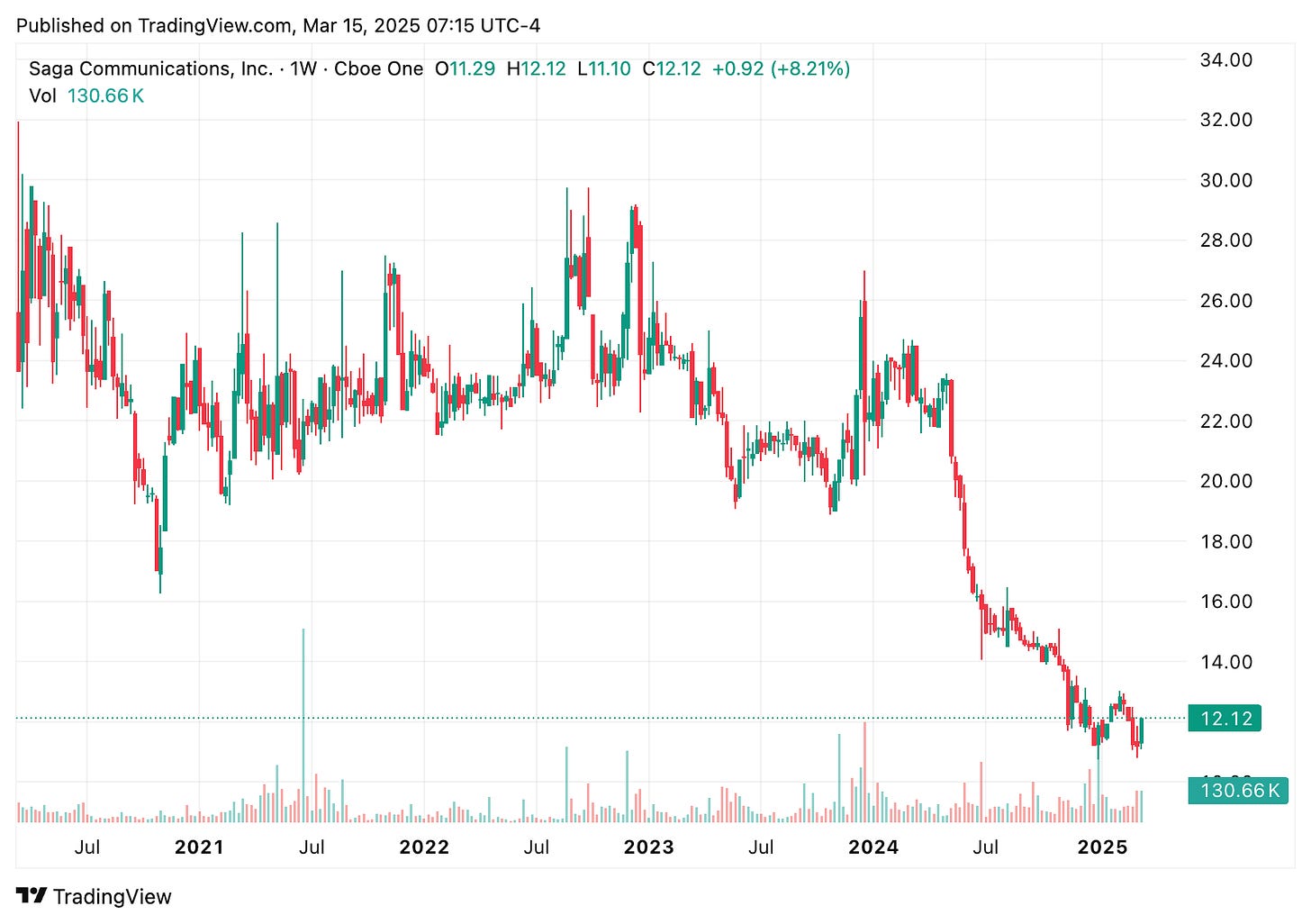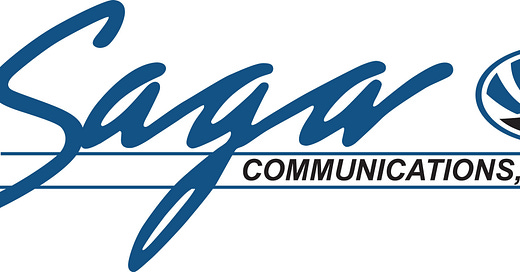Saga Communications: Finding Value in a Melting Ice Cube
Saga Communications is trading at 2/3 of my fair value estimate despite cyclical and secular challenges to radio broadcasters
For a while now I have been wanting to investigate TV and radio broadcasters because they used to be cash generating machines, but now are perceived as being obsolete. It is obvious that technology has supplanted these dominant forms of media, but even melting ice cubes might be worth something at the right price. Like many TV or radio broadcasters, Saga Communications is trading at a deep discount to book value. However unlike most broadcasters, Saga has very little debt and a lot of cash on the balance sheet, which seemed like the ideal capital structure for an uncertain industry.
Over the last few years, Saga’s stock price has hovered around $22, but last year it dramatically dropped down to around $11 a share. Currently Saga has a $73M market capitalization, an 8% dividend yield, and trades at 0.42x book value. Saga looks like an attractive microcap, but I needed to mentally overcome the hurdle of radio being a declining industry. In this post I try to provide some context for the decline in radio advertising revenue and discuss how Saga is trying to navigate this scenario. Also I spend some time trying to value Saga appropriately given the uncertainties in its industry. As a sneak peak, I think Saga is undervalued but the thesis depends on the health of Main Street and consumer confidence in the medium term.

Business Description
Saga Communications was founded in 1986 and was led by its founder and longtime CEO until his passing in 2022. The current CEO, who had worked at the company for decades prior, took the helm following this transition. Saga operates a total of 82 FM stations, 32 AM stations, and 79 metro signals, with its top five revenue-generating markets being Charleston, Columbus, Des Moines, Milwaukee, and Norfolk. The company’s revenue model is heavily concentrated on local businesses, which contribute approximately 90% of its ad revenue.
For many broadcast TV and radio companies, political ad spending plays a significant role in financial performance. However, Saga’s exposure to political ad revenue is minute, with political spending accounting for just 3% of revenue in 2024. To mitigate the decline in traditional radio advertising, the company has been working to build out digital revenue sources. This includes streaming radio as well as creating locally focused news content, aiming to fill the gap left by the decline of local newspapers. The CEO has highlighted potential synergies between digital and radio advertising, given that Saga already has established relationships with local businesses. In theory, this makes digital advertising a natural extension of its existing business. Currently, digital revenue is a bit under 10% of total sales but has been growing at a healthy rate. Unfortunately Saga does not disclose specific profitability metrics for the digital side of its business, making it difficult to know if its a worthwhile investment.
In terms of capital allocation, Saga has made a few microscopic acquisitions in recent years, then a larger $5 million deal last year. It remains unclear whether this particular acquisition was a good use of capital, but at least one fund with a significant stake in the company has voiced concerns about it. Saga has not engaged in substantial share buybacks, instead focusing on dividends. The company pays a regular quarterly dividend and, in recent years, has issued sizable special dividends. It appears that when the founder passed away, Saga had built up a significant cash reserve, much of which has since been distributed to shareholders. While the company still holds a decent cash balance, the current state of the radio industry suggests that special dividends may be paused going forward. That being said, management has indicated that they are considering some level of share repurchases as part of their capital return strategy.
Why its Cheap
Saga Communications is out of favor due to both cyclical and secular declines. It is no surprise that radio is a shrinking industry, given the wide variety of content available through the internet. However, Saga’s challenges are not just industry-wide; they are also tied to broader economic conditions. About 90% of the company’s ad revenue comes from local businesses, and recent earnings calls have highlighted that Main Street is struggling. As a result, these businesses have pulled back on advertising spending. For example, a sizeable portion of Saga’s customers are car dealerships, which have seen slower sales due to high vehicle costs and rising interest rates. While some consumers remain financially strong, others are cutting back on spending. From a cyclical standpoint, the best investors can hope for is a rebound in consumer confidence to drive a recovery in local ad spending.
To better understand the long-term decline of the radio industry, I looked into trends in radio ad spending. According to Statista, radio ad revenue peaked at $18 billion in 2006, remained stable at $14 billion from 2010 to 2016, and has trended downward since. Over-the-air (OTA) revenue is expected to decline to $10.8 billion in 2024. However, digital revenue has grown, partially offsetting the losses in OTA, with digital radio ad revenue expected to reach $3 billion in 2024. This brings the total projected industry revenue to $14 billion, the same level as a decade ago. S&P forecasts that local radio ad revenue will continue to decline in the mid-single digits, while digital sales grow modestly at about 3% per year. Overall, S&P projects a gradual decline of a few percentage points annually for total local radio ad revenue. Political advertising does provide some revenue boosts, but for Saga, this appears to be a smaller portion of sales compared to other broadcasters.
Saga’s largest asset on its balance sheet is the intangible value assigned to its radio licenses. The company reassesses this valuation quarterly and discloses the assumptions used in its SEC filings. Some of these assumptions, such as estimated station profit margins and discount rates, fluctuate each quarter. If the calculated value of these licenses falls below the stated book value, Saga would be required to recognize an impairment charge. In the most recent quarterly report, the company used a 10% discount rate, assumed station operating margins between 17.8% and 36.4%, and projected long-term revenue growth of 1-2%. The report also stated that even if license values declined by 10-30%, no impairments would be necessary. Several other publicly traded radio companies have recorded impairments to their station licenses, yet Saga has avoided this so far. While this is a positive sign for now, continued deterioration in the industry could eventually lead to impairments in the future.
Saga’s strategy in recent years has been to diversify beyond traditional radio and build up its digital advertising revenue. Many other radio companies are attempting the same transition. Townsquare Media, looks like a good example of this, but their high debt load turned me off as an investment. With careful capital allocation, Saga may be able to manage the industry's decline in a way that avoids a sudden collapse. A gradual wind-down strategy, by selling or closing stations and returning cash to shareholders, could allow the company to maintain stability as long as expenses decline in proportion to revenue.
Saga does not provide much detail about the specific costs associated with operating its stations, but a significant portion appears to be personnel expenses. In a recent earnings call, an analyst asked whether costs could be reduced by consolidating ad sales and programming teams across multiple stations. Saga acknowledged that this was possible but emphasized the importance of maintaining a strong local presence to foster better relationships with small businesses. While this approach seems reasonable for now, it is nice to know that the company has a potential fallback plan for reducing costs in the future.
Valuation
Bruce Greenwald’s value investing book provides a solid framework for determining the appropriate valuation method that should be used. He recommends calculating the reproduction value of a company’s assets, essentially estimating how much it would cost to start an equivalent business from scratch. While this may be similar to book value, some assets might be undervalued on the balance sheet, and some intangible assets may not be captured in accounting figures. The reproduction value is then compared to an earnings-based valuation. If asset value significantly exceeds earnings value, it suggests the company is not generating much profit and has a low return on assets. A long history of low returns below the company’s cost of capital indicates that the company or industry may be in secular decline. In such cases, Greenwald advises discounting asset value or using a conservative earnings estimate for valuation. If a company is in serious distress, a liquidation value focusing on current assets over long-term or intangible ones may be the best choice.
Given that radio is a secularly declining industry, Greenwald’s framework is particularly useful for valuing Saga Communications. For my valuation, I’ll start with the company company generating $115 million in revenue, with a five-year gross margin of 19.3%. Assuming $11 million in SG&A expenses and a 25% tax rate, after-tax profit comes out to approximately $8.4 million. Capitalizing this at a 10% discount rate results in an enterprise value (EV) of $84 million. After adding $27.8 million in cash and subtracting $5 million in debt, the estimated equity value is $107 million. This earnings power valuation (EPV) is roughly two-thirds of book value, reinforcing the idea that Saga operates in a declining industry. However, this gap is not not massive, if EPV were only 20% of book value or if earnings were consistently negative, the situation would be far more concerning.
Saga’s reproduction value is likely higher than book value because much of its physical assets such as buildings, radio towers, and equipment have been heavily depreciated. Additionally, intangible assets like long-standing relationships with local advertisers hold value but are not reflected in accounting figures. While reproduction value suggests that rebuilding Saga from scratch would require a significant investment, the challenge is that no rational investor would attempt it given the company’s poor returns on assets. However, a liquidation valuation may not be the best approach either, as Saga is more likely to experience a gradual decline rather than an abrupt shutdown.
Given these factors, the most reasonable valuation approach is either to use a conservative earnings estimate or apply a discount to asset value to introduce a margin of safety. As an example, if the value of station licenses were cut in half and a few million were shaved off PP&E, the asset value would align more closely with the earnings power valuation. Since I have to put a stake in the ground, I’ll estimate fair value at $110 million, or $18 per share.
Beyond valuation, another complexity in assessing Saga is its management strategy. The company has focused on returning profits to shareholders while also investing in its digital business. However, building the digital segment from scratch has weighed on profit margins, reducing shareholder returns. A fund with a significant stake in Saga is advocating for a strategic shift, arguing that in-house digital expansion distracts management and may not yield adequate returns. They suggest Saga should scale back digital spending, possibly outsourcing it to specialized firms. Other public radio companies emphasize digital growth, so if Saga remains focused solely on traditional radio, it would be taking a contrarian approach. The business could succeed either by executing a transition to digital or by efficiently managing radio’s decline, but both paths require strong execution. At this point it is hard to tell which path is the optimal decision. Additionally, in their latest earnings call, Saga indicated openness to selling some stations and using the proceeds for stock buybacks.
Conclusion
Ultimately, the key question is whether Saga’s stock is a good investment. While uncertainty remains, good value investments often involve some degree of uncertainty. At its current price, Saga trades at a discount to a conservative valuation while committing to returning a substantial portion of profits to shareholders. The company’s dividend yield is over 8%, and given its current profitability and cash reserves, the payout appears sustainable for now. Over the long term, Saga’s fate depends on its ability to transition or effectively wind down its business. In the medium term, however, performance will hinge on a recovery in local advertising, which serves as the primary catalyst for Saga’s share price reaching fair value.
Over the next few quarters, it will be crucial to determine whether sales declines are cyclical or indicative of a deeper secular trend by comparing Saga’s performance to broader Main Street trends. If the industry fails to recover from this downturn, fair value estimates will need to be adjusted downward to reflect the new market realities.
Stocks mentioned: SGA 0.00%↑ TSQ 0.00%↑
Other posts you may enjoy:







